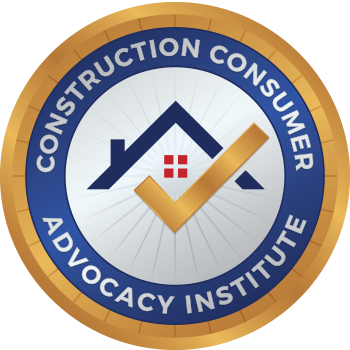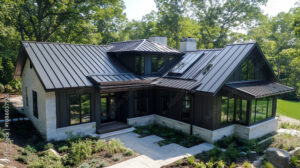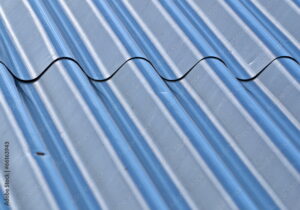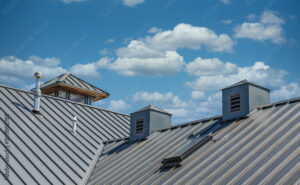When it comes to choosing a roofing material that’s durable, eco-friendly, and aesthetically pleasing, metal roofs are often at the top of the list. However, narrowing it down further can be challenging, especially when faced with two popular options—corrugated metal roofs and standing seam metal roofs. Both offer distinct advantages depending on your home’s design, budget, and environmental goals.
If you’re planning a roofing project or simply exploring sustainable lifestyle upgrades, this guide breaks down the key differences, pros, and cons of these two metal roofing systems.
What is a Corrugated Metal Roof?
Corrugated metal roofs are characterized by their wavy, ridged panels. Originally associated with agricultural and industrial buildings, they have gained immense popularity in residential applications due to their cost-effectiveness and rustic charm.
Key Features:
- Material: Made from steel, aluminum, or galvanized metal, coated for added durability.
- Design: Panels with repetitive grooves and ridges.
- Installation: Attached using exposed fasteners (visible screws).
What is a Standing Seam Metal Roof?
Standing seam metal roofs feature flat panels with raised vertical “seams” running from the roof ridge to the eave. This sleek and modern design makes it a favorite for contemporary and eco-friendly home designs.
Key Features:
- Material: Usually made from steel, aluminum, or copper, often painted or coated for longevity.
- Design: Flat panels separated by raised seams.
- Installation: Attached using concealed fasteners (hidden clip systems).
Corrugated Metal Roof Pros and Cons
Pros:
- Cost-Effective: Corrugated metal roofs are generally more affordable than standing seam systems, making them ideal for budget-conscious homeowners.
- Easy Installation: Their lightweight nature and straightforward installation process mean reduced labor costs.
- Rustic Appeal: Perfect for homes aiming for a rustic, industrial, or farmhouse look.
- Durability: With proper maintenance, corrugated panels are highly resistant to weather, providing decades of reliable coverage.
Cons:
- Exposed Fasteners: Screws and fasteners are visible, which can compromise weather-tightness over time and require regular maintenance.
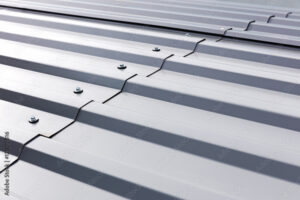
- Less Modern Look: While charming, corrugated roofs may not align with sleek, contemporary design aesthetics.
- Lower Resistance to Expansion and Contraction: The design of exposed fasteners can allow movement, leading to potential leaks if not inspected and maintained.
Standing Seam Metal Roof Pros and Cons
Pros:
- Sleek and Modern Design: The clean lines of concealed fasteners create a polished and sophisticated look that suits contemporary homes.
- Superior Weatherproofing: Raised seams and hidden fasteners offer better protection against weather leaks and expansion due to temperature changes.
- Longer Lifespan: This roofing system is highly durable and, with proper installation, requires less maintenance than corrugated roofing.
- Energy Efficiency: Standing seam roofs can easily accommodate solar panel installation, making them a sustainable choice for eco-conscious homeowners.
Cons:
- Higher Cost: The material and installation costs for standing seam metal roofs are typically higher than corrugated roofs.
- More Complex Installation: The hidden fastener system requires more time and expertise, leading to higher labor expenses.
- Industrial Look on Traditional Homes: While suitable for modern designs, the clean aesthetic might not blend well with traditional or ornate home styles.
Which Option is Right for You?
The choice between corrugated and standing seam metal roofs comes down to your priorities, budget, and home’s aesthetics. Here’s how to decide:
- Choose Corrugated if you’re on a budget, love rustic aesthetics, and want a roofing solution that’s easy to install. It’s great for traditional or rustic homes that benefit from the ridged texture of corrugated panels.
- Choose Standing Seam if you’re looking for a modern design, superior weather-tightness, and long-term durability. This system is perfect for sustainable homes with plans to incorporate solar panels or rainwater collection.
Shared Benefits of Metal Roofs
Regardless of the type, both roofing systems offer notable advantages over traditional materials like asphalt shingles or clay tiles, including:
- Eco-Friendliness: 100% recyclable materials and the ability to reflect heat, reducing cooling costs.
- Durability: Resistant to fire, wind, and weather damage, with lifespans often exceeding 50 years.
- Lightweight: Reduces strain on your home’s structural framework compared to heavier materials like slate or tile.
Final Thoughts
Whether you opt for the rugged charm of corrugated metal or the sleek sophistication of standing seam, metal roofing is an excellent investment for long-lasting durability, sustainability, and style.
If you’re still on the fence, consult a roofing professional or eco-minded builder to weigh your options. A custom approach will ensure your next roof not only looks great but also aligns with your long-term goals for sustainability and functionality.
Are you considering a metal roof for your next project? Drop a comment below or share your thoughts!
For Tons of Great Free Information please hit “Like & Subscribe”
Websiteconstructionconsumeradvocacyinstitute.com
Podcastanchor.fm/galloway
www.youtube.com/@ConstructionConsumerAdvocacy
